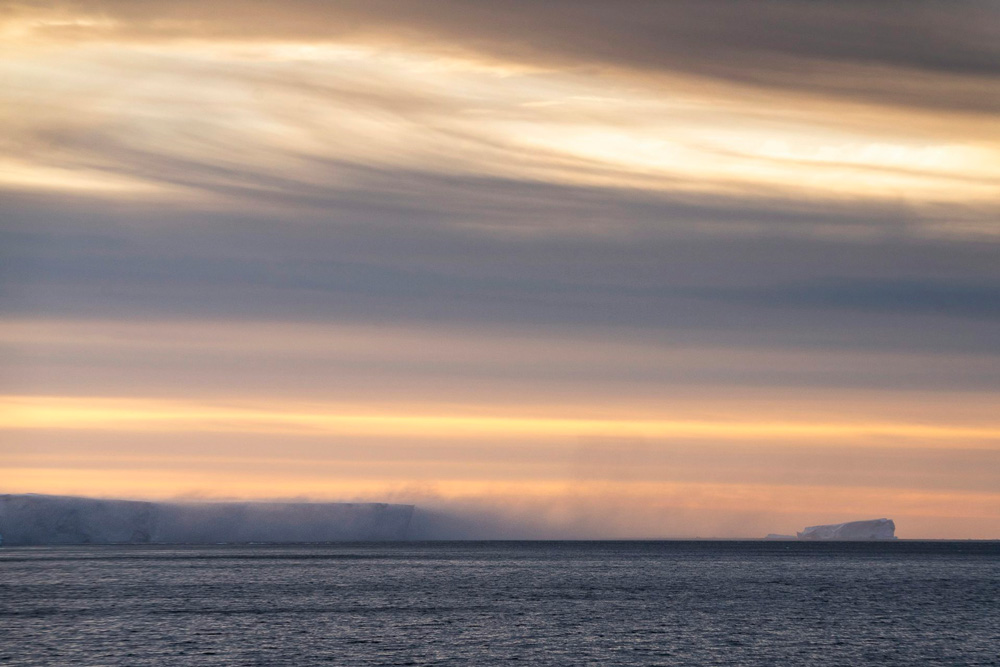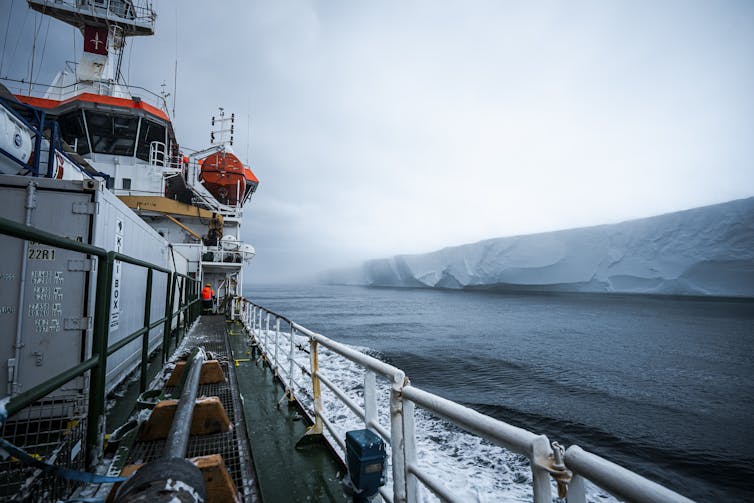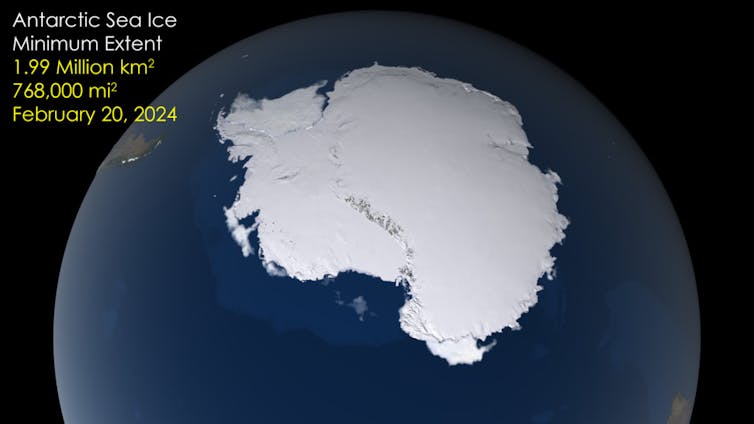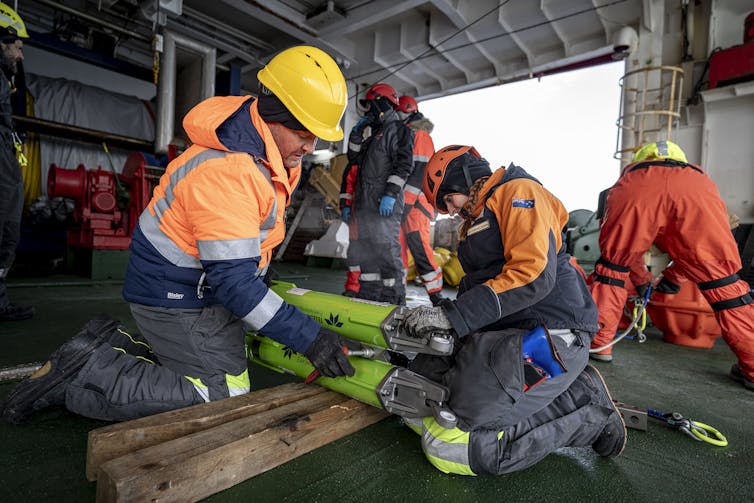
By Craig Stevens
At the end of the southern summer, Antarctica’s sea ice hit its annual minimum. By at least one measure, which tracks the area of ocean that contains at least 15% of sea ice, it was a little above the record low of 2023.
At the time, I was aboard the Italian icebreaker Laura Bassi, ironically surrounded by sea ice about 10km off Cape Hallett and unable to make our way to one of the expedition’s sampling sites.
Even just a decade ago, sea ice reliably rebuilt itself each winter. But something has changed in how the Southern Ocean works and the area covered by sea ice has decreased dramatically.
Our aim was to track the changes happening in the ocean around Antarctica and to make targeted measurements of some of the processes we think are responsible for this loss of sea ice. Most likely, this is a consequence of warming oceans and so we focused on identifying the pathways warmer seawater could find to drive more melting.
The southernmost shelf sea
The annual freeze-thaw cycle of Antarctic sea ice is one of the defining properties of our planet.
It affects the reflectivity of a vast area of the globe, oxygenates the deep ocean, provides habitat across the Southern Ocean food web and plays a role in the resilience of ice shelves.
The voyage was led by a team of scientists who coordinate Italy’s longstanding research in the Southern Ocean.
For decades, they have been maintaining instruments in the Ross Sea region and the data they have been collecting are now proving crucial as we seek to understand the implications of sea-ice changes in terms of physics and biogeochemistry.

Lana Young/AntNZ/NIWA/K872, CC BY-SA
The expedition sailed a two-month counter-clockwise loop of the continental shelf in the Ross Sea. Continental shelves are shallower and biologically very productive regions that surround all of Earth’s continents.
Continental shelf seas around Antarctica are special because of the presence of sea ice – but this varies in space and time.
The US National Snow and Ice Data Center has developed a visualisation tool to compare sea-ice conditions during different times.
It shows that by the end of summer, the Ross Sea region holds only a few patches of sea ice. And this year, the patches were even fewer than in the past.
The region is the southernmost open water on the planet and acts as a gateway to seawater flowing in and out under the largest (by area) ice shelf on the planet – the Ross Ice Shelf.
The sea ice we encountered came in a variety of thicknesses and snow cover. We could see that in some places, sea ice was present in densities less than a satellite could recognise, but possibly enough to have an influence on how the upper ocean exchanges heat with the atmosphere above.
The state of sea ice
This reinforced our understanding of the importance of the spatial variability of sea ice. Satellites show that most of the sea-ice coverage, at its minimum, was found in a big patch in East Antarctica, due south of Hobart, and the ice-choked Weddell Sea.
The Weddell Sea and its Filchner-Ronne Ice Shelf are the Ross Sea’s opposite. At the late-summer sea-ice minimum, the Ross Sea is largely free of ice, while the Weddell Sea stays filled with ice.
This was the pack-ice nightmare that trapped Shackleton’s Endurance over a century ago.

NASA, CC BY-SA
At a personal level, the sights during our expedition were a privilege. They took me beyond anything imagined from data and models. Giant icebergs became common place. Penguins, seals, skua and whales all passed by the ship at various times.
In the same way we send people into space, there are substantial benefits to having scientists on location developing their perspectives on the science. However, it is clear that Antarctic ocean data collection systems need to expand when and where they collect information.
The future is robotic
One feature of the voyage was the use of robots. We deployed 11 relatively simple Argo floats that will drift around the region for years, surfacing to send back data on temperature, salinity and in some cases oxygen.
We also sent three robotic ocean gliders on their data-collecting missions independent of the ship. This meant we could capture flow data in the long north-south troughs that are a feature of the region, while the ship was elsewhere.

Lana Young/AntNZ/NIWA/K872, CC BY-SA
We retrieved these robot gliders after several weeks, bringing back unique maps of changing ocean temperature and salinity. The data provide evidence of warmer water lying just beneath the edge of the continental shelf, highlighting the fragility of the system.
There is a growing sense that the Ross Sea sector will become more important in the coming decade. With substantial changes upstream in the Amundsen Sea, where glaciers are retreating at an accelerating rate, and the possibility for warmer water finding its way onto the continental shelf, there is the potential that the largest ice shelf on the planet might start to change.
Craig Stevens, Professor in Ocean Physics, University of Auckland, Waipapa Taumata Rau
This article is republished from The Conversation under a Creative Commons license. Read the original article.
![]()
Craig Stevens is Professor in Ocean Physics at the University of Auckland, Waipapa Taumata Rau, New Zealand.




























Pogo says
@FWIW
Related
As stated
https://www.wfla.com/weather/climate-classroom/ocean-temperatures-in-uncharted-territory-months-ahead-of-hurricane-season/
Ray W. says
Thank you, Pogo.
Early last August, a TV meteorologist caught my attention with his description of the issuance of an “excessive heat warning” for most of Central Florida.
The weatherman went on to explain the matrix used by the National Weather Service, a sub-agency within NOAA. He stated that in 1978 the matrix had replaced an older matrix. In its 45 years of its use, the NWS had never released an excessive heat warning for Central Florida. Yet here we all were.
I learned that a “heat dome” centered over Texas was slowly headed our way. It spread from West Texas to Florida. It lasted for roughly two weeks. Day after day, the weatherman announced new excessive heat warnings. I lost count but as I recall Central Florida was the subject of no more than 10 excessive heat warnings.
I began paying more attention to the FlaglerLive weather commentary. Mr. Tristam, apparently goaded by adherence to a duty of care that we all owe each other, warned his readers against too much exposure to the heat. He published heat indexes, some as high as 120 degrees, each day. I had never seen such heat indexes in this area of the state before. I would check my own weather app for heat indexes. I saw 115 degrees on my app, in Volusia County. Flagler County, with all its wetlands, may experience higher heat indexes due to higher humidity values.
I came across an article out of a Texas region; it explained the reason for a suddenly reduced overall oil refinery output in Texas: the heat dome. Refineries become less efficient when heat values rise above certain thresholds. Overall national gasoline production dropped for those two weeks of excessive heat. Gasoline prices suddenly bumped up. The gullible amongst us immediately blamed the administration; they were wrong.
A short time ago, Mr. Tristam published an article about workers suffering injury and sometimes death from exposure to excessive heat. One clueless commenter opined that workers alone bore all responsibility for protecting themselves from such heat values. In my reply, I mentioned that all employers owe a duty of care to their employees, and that the commenter was actually thinking backwards; he later whined in a personally irresponsible manner that he had been misunderstood. But I didn’t further define in that comment the duty of care that we all owe each other.
I admit there is more than one definition of “duty of care.” The one I selected for FlaglerLive readers is:
“A legal obligation imposed on an organization, requiring adherence to a standard of reasonable care while preventing any acts that could foreseeably harm others.”
Every business, either sole proprietor or multi-national conglomerate, every citizen, owes a duty of care to everyone else. If the day’s heat index in Flagler County is predicted to hit 120 degrees, if the NWS issues an excessive heat warning for the region, then every employer immediately owes a heightened duty of care to those of its employees who work outdoors. The duty of care may call for work breaks every hour, for additional access to hydration products, for extra watchfulness, regardless of what some statute requires as a minimum.
Each of us, when we engage the transmissions of our vehicles to achieve or goals of the moment, assumes a duty of care to every other motorist or pedestrian we encounter. Violating that duty of care by carelessness is one thing, recklessness another. Engaging in an act of culpable negligence, or excessive recklessness, a third thing. The first might net a civil traffic infraction, the second a misdemeanor charge, the third a felony charge.
Black’s Law Dictionary has a much more expansive definition of “Care”:
“As a legal term, this word means diligence, prudence, discretion, attentiveness, watchfulness, vigilance. It is the opposite of negligence or carelessness. There are three degrees of care in the law, corresponding (inversely) to the three degrees of negligence, vis., slight care, ordinary care, and great care. The exact boundaries between the several degrees of care, and their correlative of carelessness, or negligence, are not always clearly defined or easily pointed out. We think, however, that by ‘ordinary care’ is meant that degree of care which may reasonably be expected from a person in the party’s situation.”
This is why I expect more of commenters like Dennis C. Rathsam, JimboXYZ, and their compatriots. Do they, should they, owe all FlaglerLive readers a duty of care to be honest, to be thorough, to be precise. Careless commentary, intentional disinformation, reckless misinformation, harms us all. ASF is hopelessly lost in a miasma of conflicting emotions; she hates without understanding, accuses without basis, omits without reason. I oppose her in part because her way of thinking harms the plight of all Israeli peoples, though some Israelis bring on that national harm by their own actions.
Can it be argued that true conservatism has an element of a duty of care to all in its DNA? That the conservative impulse behind the Declaration of Independence grew from an understanding of a common duty of care to all?
“We hold these truths to be self-evident, that all men are created equal, that they are endowed by their Creator with certain inalienable Rights, that among these are Life, Liberty, and the pursuit of Happiness.”
Do all FlaglerLive readers see “duty of care” to all in these words? Is this the foundation of our experimental liberal democratic Constitutional republic? Is this the impetus, the driving force, behind the struggle for all minority efforts to achieve equality? That we all owe a duty of care to everyone?
Pogo says
@Ray W.
Thank you; for the intellectual excellence of your comment(s), for your seriousness, intelligence, courtesy and thoughtfulness.
endangered species says
ron banned climate change and homeless so how is this still an issue. He really needs to ban thermal dynamics I guess. Long term impacts? lol long term ten years ago the goal was 1.5C by 2100, we hit that in 2023…. Happy Hurricane season.
Billy says
Leftist Propaganda!
Ray W. says
Maybe so. Maybe not. I remain unconvinced that you know enough to tell the difference. Keep trying. Start by exercising a little intellectual rigor. Use reason. Who knows the epiphanies you might experience.
The dude says
Tell Flagler Beach that… while it’s still there, and you can. Which, in a decade or so, will either be underwater or just a seawall nestled up against A1A to keep the road from further washing away.
Enjoy your strengthening hurricane seasons while you deny the simplest of facts and science.
MAGA is nothing if not consistent.
Sherry says
@ The Dude. . . as often, you are right on! Thanks!
Pogo says
@Singing in the rain…
Sexy white lift boots may not be enough
https://www.msn.com/en-us/weather/other/forecast-group-predicts-busiest-hurricane-season-on-record-with-33-storms/ar-AA1nBEbz